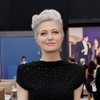GARAGE is a print and digital universe spanning the worlds of art, fashion, design, and culture. Our launch on VICE.com is coming soon, but until then, we're publishing original stories, essays, videos, and more to give you a taste of what's to come. Read our editor's letter to learn more.Just before 10 p.m. on Tuesday, Raf Simons packed a few hundred people to an open air alleyway marketplace under the Manhattan Bridge for his New York Fashion Week: Men's show. Chinese women were giving out Fiji Water and Tsingtao from the metal street carts that usually dispense stuffed lotus leaves and chicken on a stick; Chinese lanterns printed with Peter Saville's album covers for New Order and Joy Division swung lazily from the bridge's abutments. The pavement had an apocalyptically wet sheen, and the word "REPLICANTS"—a reference to the bioengineered specimens hunted down in Blade Runner—scrolled across L.E.D. banners that were almost indistinguishable from signs for bakeries, preschools, and clothing stores selling jelly sandals and printed polyester tops with trendy elaborate sleeves. Jake Gyllenhaal slouched his shoulders to wedge in among the skateboarder intelligentsia, and A$AP Rocky admired Marc Jacobs's Gucci kangaroo fur slides under a heavenly cloud created by Jacobs's vape. Moments before the show began, Julianne Moore, who typically appears on the fashion scene as the Pythia to Tom Ford's Apollo, was escorted to the end of the pedestrian arcade space that was the ipso facto runway.
Advertisement
A woman in front of me was trying to explain to a friend via text where she was standing—"I don't know!!!!!" she typed. "Everything is in Chinese!!!!!" She looked at me helplessly: "Where are we?"I suppose we were in the coolest place in the universe. Simons is the most exciting designer in New York right now—the most exciting in a long time: a European imported to wake a sleeping giant of a brand, Calvin Klein, and who reported for duty as a menswear hero with Dior credentials. (The menswear community refers to him by turns as "Raf" and "the God.") His presence in New York is at once exalted and humbling; it's less a rejection of the city's second fiddle status and more a recognition that New York's love of fashion is worthy of the caliber of designer usually reserved for our more refined international counterparts.Simons has been quietly showing his own brand for the last two decades—the real work to follow is his top-to-bottom remodel of Calvin Klein, of which he's only shown one season thus far. The energy around the show was frankly more important than the clothes—a series of raincoats and skinny layered garments that put the wardrobe of a person collecting bottles around Canal Street and Blade Runner's apocalyptically oversized trench coats together and hit "pulse." Every model carried an umbrella with a glow stick shaft. It's the kind of item that will sell out in minutes at Dover Street Market and be greeted for years to come with a reverential tweetstorm whenever it pops up on men's luxury resale site Grailed.Despite earlier rain and the kind of suffocating heat that would drive a '30s noir heroine to shoot her cheating husband in a tenement apartment, people crammed into the makeshift front row and craned their necks and phones into the runway, flipping their heads to see the next look with the kind of vigilance usually reserved for jaywalking at a chaotic Manhattan intersection.The mood was exuberant, even delighted and casual, in spite of the dystopian atmosphere; Simons took a gracious jog around the runway after the finale, and then greeted fans and friends (in Simons's world, most are both) near the exit. His reliance on references—the Replicants signage, all the nods to New Wave bands, and the art world collaborations, particularly with Sterling Ruby, that often serve as inspiration for his collections—are the sort of tactics that often make other designers' work feel exclusionary or out of reach. (As a Southern grandmother might say, "It's very European.") But something about Simons's cult of personality makes his insidery shout-outs and avant-garde designs feel welcoming rather than detached; they're the expressions of an outsider seeking kindred souls. Even his integration of Chinatown's icons—the carts, the signs, even the people—felt inclusive rather than appropriated. There's a sense, especially now that he's in New York, that Simons commands respect because he represents a cerebral sincerity.Coming off of the Paris Couture shows, many editors and buyers expressed that the moment for cool detachment and cynicism in clothing had ended—that now there is a hunger for emotion, beauty, and sincerity. In an interview with GQStyle in January shortly before his first Calvin Klein show, Simons, who trained as an industrial designer, stated that he'd once had a conflicted relationship with fashion, "because I thought it was a lower form of creative expression…. I thought, Oh my, we just keep on producing clothes, clothes. Like, we could do something so much more relevant, you know? Until one person said to me—and I'm not going to name the person—but the person literally slapped me in the face and said, you have to start looking at it differently, because otherwise you're never going to be proud and happy about what you do. Because you inspire people. You bring something out that they literally need. So you do a good thing. Not a bad thing. And that's how I've started to think lately."The morning after the show came news that yet another of New York Fashion Week's marquee designers, Joseph Altuzarra, will show in Paris. With more and more designers leaving the city, what does New York stand for in the world of fashion? Simons hasn't yet had enough time at Calvin to show us yet, but unlike Proenza Schouler, Rodarte, and Altuzarra, Simons is already comfortable here. He proved himself at Dior. Rest assured that in New York, he's doing a good thing.
